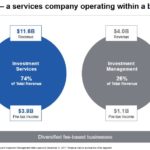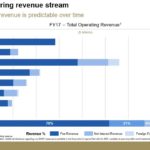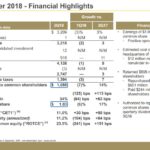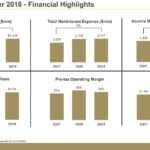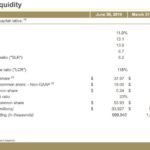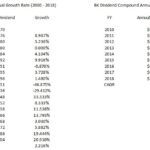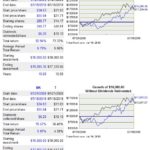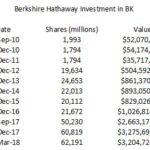Contents
Summary
- This company is the largest player in a highly regulated industry and is deemed to be a Global Systemically Important entity.
- Dividend distributions and share repurchases come from profits generated from normal business operations as opposed to the issuance of debt.
- The barriers to entry are very high to the extent where the probability of being displaced by a new market entrant is extremely remote.
- A rising interest rate environment favors this business.
- My favorite investors have invested billions in this company and have been significantly increasing their holdings over the past several quarters.
- The recent pullback in this company’s stock price has restored valuation to a reasonable level.
Introduction
In my January 21, 2018 ‘High Entry Barriers Work in Its Favor’ article I concluded with the following comment:
‘I intend to acquire additional (stock symbol) shares at some point but not now. My concern at the moment is that there is an element of irrational exuberance which has contributed to the dramatic run up in (stock symbol’s) stock price in recent months. While I do not envision a recession in the short-term, I suspect there will be some event which will present us with a more favorable (stock symbol) purchase price in 2018 than the current price.’
As luck would have it, this company has recently released its Q2 results and the share price has pulled back.
In the Q2 earnings call with analysts, this company’s CFO indicated:
‘The lost business is primarily driven by a couple of clients. One was the result of industry consolidation and the other moved to another provider. The pipeline is good, but it takes time to onboard.’
While investors may not have been impressed with this company’s recent results, I view the recently reported results as encouraging. In fact, following the release of its Comprehensive Capital Analysis and Review (CCAR) results, this company was granted authorization to repurchase $2.4B in common shares by mid-2019. In addition, it was also able to announce a high teens percentage increase in its quarterly common share dividend. These approvals were granted despite the severe assumptions required to be factored into the recent CCAR.
NOTE: CCAR is a regulatory framework introduced by the Federal Reserve in order to assess, regulate, and supervise large banks and financial institutions (collectively referred to in the framework as Bank Holding Companies).
Overall, the company remains strong although some areas of the company are performing better than others. This company expects to benefit from the positive impact of higher interest rates and equity markets, although the pace of growth is expected to moderate from the previous quarter.
In my January 21, 2018 article I pointed out that my favorite investors followed my footsteps (a huge degree of sarcasm) and acquired an initial stake in this company in 2010 after I initiated a position in the company; shares are not held in the FFJ Portfolio but rather in one of our retirement accounts. At the time of that article, my favorite investors held over 50 million of this company’s shares. In conducting research for this article I learned these investors have increased their holdings to ~62 million shares.
Business Overview
The Bank of New York Mellon Corporation (NYSE: BK) was established in 1792 and is the first company listed on the New York Stock Exchange. It is a global company that manages and services assets for financial institutions, corporations and individual investors in 35 countries and more than 100 markets.
BK consists of the Investment Management and the Investment Services business segments. It offers a comprehensive set of capabilities and deep expertise across the investment lifecycle which enables it to provide solutions to buy-side and sellside market participants and leading institutional and wealth management clients.
The Investment Management segment provides investment management services to institutional and retail investors, as well as investment management, wealth and estate planning and private banking solutions to high net worth individuals and families, and foundations and endowments.
The Investment Services segment provides business and technology solutions to financial institutions, corporations, public funds and government agencies, including: asset servicing (custody, foreign exchange, fund services, broker-dealer services, securities finance, collateral management and liquidity services), clearing services, issuer services (depositary receipts and corporate trust) and treasury services (global payments, trade finance and cash management).
As at December 31, 2017 (most recent fiscal year end), BK had $33.3T in assets under custody and/or administration and $1.9T in assets under management.
Investments in technology and operations to increase resiliency, improve efficiency and reduce risk continue to be a significant priority. Excellence in risk management is essential and BK maintains strong capital and liquidity positions to support its business activities and client needs.
BK is deemed to be a U. S. Global Systemically Important Bank and is required to be in compliance with various capital ratios. The stringent reporting and compliance requirements act as deterrent to new entrants in that the costs associated with complying with various regulatory requirements is significant.
Under the Dodd-Frank Wall Street Reform and Consumer Protection Act of 2010, BK must periodically submit to the Board of Governors of the Federal Reserve System and the Federal Deposit Insurance Corporation a plan for its rapid and orderly resolution in the event of material financial distress or failure.
Subsequent to the review of BK’s 2017 resolution plan, the agencies jointly decided there are no deficiencies or shortcomings in the 2017 plan and the filing deadline for the next plan submission has been extended by one year to July 1, 2019.
BK’ s March 8, 2018 Investor Day Presentation
Although I highly recommended this 139 page presentation be reviewed by any investor interested in investing in BK, I provide the following screen shots I found to be of interest.
Source: BK - March 8, 2018 Investor Day Presentation
Q2 and 6 month FY2018 Results
BK’s results can be found here.
EPS rose 17% from Q2 2017 with YoY revenue growth of 5% and YoY expense growth of 3%.
Focus continues to be on increasing the rate of revenue growth.
The nature of the business is such it takes time to onboard new clients and drawing conclusions based on an individual quarter is of little relevance.
BK continues to benefit from the positive impact of higher interest rates and stronger equity markets, albeit at a more modest pace than Q1.
In the asset servicing business, BK saw steady performance in its core custody, middle office and fund accounting revenues and saw growth in securities lending where BK witnessed increased demand for U.S. government securities in equities. There was also good growth in foreign exchange revenue which was driven by higher volumes for market activity and from new business wins predominantly from asset servicing clients.
BK continues to enhance its capabilities and recently launched new foreign exchange products to better service its clients (ie. FX prime brokerage and FX options). Emerging markets capabilities were also enhanced.
The pipeline and demand for asset servicing services is solid and its strength in the end-to-end fund administration solutions business (includes institutional transfer agency services) allows BK to differentiate itself from its competition.
There have been a number of new wins in mandates, especially in the U.S. and Canada. Q2, however, saw the loss of 2 clients (one was the result of industry consolidation and one was a move to another service provider) which BK was expecting. These losses will negatively impact BK on a YoY basis for the next few quarters. On a positive note, BK is in the process of on-boarding several large clients which will positively impact results starting predominantly in the second half of 2019.
Source: BK – July 19, 2018 Q2 Financial Highlights
Credit Ratings
BK’s credit ratings from Moody’s, S&P, Fitch, and DBRS can be found here. The ratings for the various BK entities differ but all the long-term credit ratings are investment grade. I am comfortable with the level of risk I am assuming by investing in BK.
Dividend, Dividend Yield, and Dividend Payout Ratio
BK’s dividend and stock split history can be found here. During Q2, BK paid $0.244B in dividends to common shareholders.
As I compose this article, I note that BK has not yet updated its website to include the increase in its quarterly dividend which was announced July 19th.
The new quarterly $0.28 dividend is a 17% increase from the most recent $0.24 quarterly dividend.
The following chart reflects the compound annual growth rate (CAGR) of BK’s dividend over two timeframes.
BK’s dividend increases do not coincide with its fiscal year end and calendar year end. My calculations are based on the dividend for the fiscal/calendar year which explains why the 2018 dividend increase I report is ~21% versus the 17% increase reflected in BK’s July 19th dividend increase Press Release.
I recognize many investors may eliminate BK as a potential investment because of the low dividend yield of ~2.1% (based on the July 19 $52.73 closing stock price). I think this would be a mistake and provide the following BK versus AT&T (NYSE: T) comparison to explain why.
I have specifically selected T for comparison purposes because I know many investors invest in T because trading volume is significant, and the dividend and dividend yield are attractive.
Please note that my calculations do not factor into the equation the reinvestment of dividends. In addition, I have only used 12% growth in BK’s annual dividend versus the ~14% growth rate evidenced over the past 8 years.
Based on my calculations, a ~$20,000 investment in each company based on current market price will result in BK generating more in annual dividend income than T come year 12. I know 12 years into the future might seem like a long way off and much can happen during this timeframe but the purpose of this exercise is to demonstrate that low dividend yield stocks should not be completely eliminated as potential investments if you are prepared to invest in great companies for the long-term.
Those calculations were projections. Let’s see how BK and T have performed on a total return basis for the last 10 and 20 years on the basis of dividends reinvested / not reinvested. The variance over the 10 year timeframe is not that significant but over 20 years, BK has definitely outperformed T.
Source: Tickertech
I totally understand that I am comparing 2 vastly different companies so it is not an ideal comparison. Had I invested in these two companies 20 years ago, however, I would now be much happier with my BK investment.
The current mean FY2018 adjusted EPS projection from 20+ analysts is ~$4.21 so the $1.12 annual dividend is a ~27% dividend payout ratio. I am confident BK will easily be able to service its dividend.
Share count continues to decline. During Q2, BK repurchased 12 million common shares for $0.651B.
As at the end of FY2013 there were ~1154 million diluted common shares and equivalents outstanding. For the quarter ending June 30, 2018 the average diluted common shares and equivalents outstanding amounted to ~1014 million (as per July 19th News Release). In addition to the reduction in share count over the past few years, BK recently received regulatory approval for the repurchase of $2.4B in common shares by mid-2019.
Valuation
In mid-June, BK was trading close to $58 for a forward adjusted PE of ~13.78 based on adjusted EPS expectations of ~$4.21 for FY2018. With BK having closed at $52.73 on July 19th, we now get a forward adjusted PE of ~12.5 which is below 2013 – 2017 levels. I now find the shares to be attractively valued.
Final Thoughts
I view BK as an attractive investment for the following reasons:
- it operates in a highly regulated industry;
- it is the largest global custodian in the world with State Street (NYSE: STT) being #2 (this is a business of scale);
- continuous technological improvements are required in order to drive down operating costs. This is cost prohibitive for smaller competitors;
- the barriers to entry are very high to the extent where the probability of being displaced by a new market entrant is extremely remote;
- the sales cycle is lengthy so a new entrant would be incurring significant expenditures before meaningful revenue can be generated;
- reputation is key as customers must have complete confidence in their ability to obtain their funds as required;
- a rising interest rate environment favors BK;
- customers tend to be sticky because switching service providers is extremely disruptive;
- shares are currently reasonably valued;
- Berkshire Hathaway (NYSE: BRK.b) has invested in excess of $3B in BK as at March 31, 2018 (the most current 13F-HR) and this position has been increasing.
I recognize some of the above noted advantages can be viewed as disadvantages. Operating in a very highly regulated industry, for example, means continuous scrutiny by various regulatory bodies which results in increased expenses.
Furthermore, unlike companies in many other industries BK requires regulatory approval to repurchase shares or to increases dividends. While this can be viewed as a disadvantage, I view this as an advantage. This means BK cannot leverage its balance sheet for the purpose of repurchasing shares/increasing dividends. BK must actually generate profits and free cash flow.
BK was trading at ~$57 when I wrote my January 21, 2018 article but with the recent pullback I now view the shares as fairly valued. I intend to acquire more shares for the retirement account which currently holds BK shares.
Thanks for reading!
Note: I sincerely appreciate the time you took to read this article. Please send any feedback, corrections, or questions to [email protected]
Disclaimer: I have no knowledge of your individual circumstances and am not providing individualized advice or recommendations. I encourage you not to make any investment decision without conducting your own research and due diligence. You should also consult your financial advisor about your specific situation.
Disclosure: I am long BK.
I wrote this article myself and it expresses my own opinions. I am not receiving compensation for it and have no business relationship with any company whose stock is mentioned in this article.



